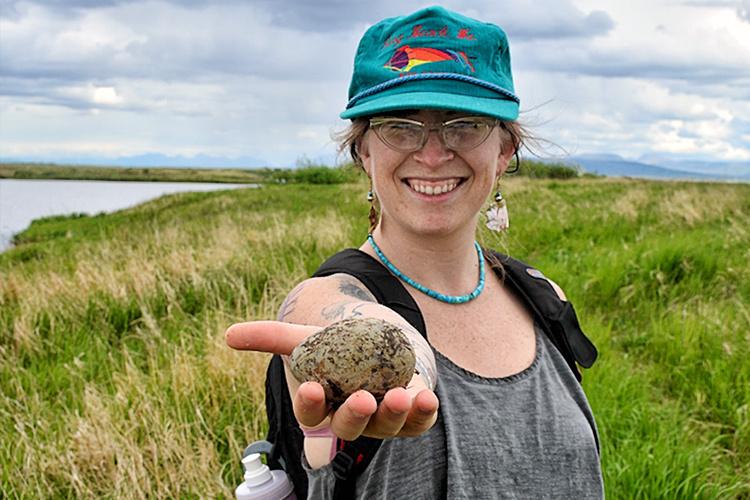During our first week and half in the field, we had some incredible experiences. We conducted our first interviews; tried subsistence-harvested foods, including berries and sockeye salmon; and watched fishermen set their lines in anticipation of the king salmon arriving. We also had a fourth member join our team. Kitty Sopow hails from Sitka, Alaska, and is interning with the Bristol Bay Native Association (BBNA) for the summer. She has a dog named Fawn and shared some of her own subsistence practices with us. She fishes for salmon, hunts deer, and harvests mushrooms, berries, and medicinal herbs like Devil’s Club. Kitty assisted us with interviews and served as our community liaison.
Conducting the Interviews
We started in Dillingham, Bristol Bay’s central hub, where we had the privilege of working with the staff of the BBNA, who all were incredibly helpful and welcoming. We attended BBNA’s annual picnic, and their staff put us in touch with key individuals for interviews.
We were fortunate to observe and document subsistence set net fishing around town along the Nushagak as king salmon started coming in. Set net fishing is typically done from land with one end of the line anchored on shore and the other end in water. Subsistence set netters in this area typically use 10-fathom gillnets. The net is attached to a lead line and a cork line and is set at low tide. As the tide comes in the cork line lifts the net in the water. Passing salmon are caught in the net and are revealed again when the tide goes out. Set netters diligently watch the tides to determine when they need to check their nets; sometimes this means going out at 3:00 am in the morning! Arriving too late exposes the salmon to seagulls, which will eat the eyes and egg sacs of the salmon.

Misty Nielsen catches a king salmon in a subsistence set net.
We conducted five oral histories during our first week in Dillingham, focusing on Alaska Native women who fish in Bristol Bay. Oral histories are in-depth interviews that document personal narrative and life experience. We heard some incredible stories from women who have been fishing for 20+ years in commercial and/or subsistence fisheries in Bristol Bay. Fishing is an integral part of their way of life. Recurring themes in our interviews include the connection that fishing provides to the land and water and the way that fishing cements family and community bonds.
We’re also learning that these are extremely tough women! Set net fishing is very physically demanding – imagine catching around 200 fish at once and having to haul them in all by hand. In addition, there is typically 3-4 hours of processing to be done immediately after catching fish, including filleting, stripping, and vacuum packing or smoking the fish. Some residents have their own smokehouses—small, enclosed buildings that are designed to dry and smoke salmon. Smoking takes about 2 weeks to complete.

Drying fish hang in a smokehouse. Salmon is cut into strips (left) or is hung as split fillets (right). Slices are made in the fillets to allow for increased air circulation.
In our next installment we will share a bit more about the second half of our trip, what we’re learning through these oral histories and what we’re planning to do with this research. Special thanks to NOAA Preserve America and the Pacific States Marine Fisheries Commission for providing funds and support for this study, and to the Bristol Bay Native Association for partnering with us on this project.

Jean Lee sets up for an oral history interview.
Meet the Bloggers

Kim Sparks, Anna Santos, Jean Lee
Kim Sparks
Kim works as a social scientist at Pacific States Marine Fisheries Commission and works as a grantee at the Alaska Fisheries Science Center. Kim has a bachelor's degree in environmental biology from Westmont College and a master’s degree in marine affairs from the University of Washington. She joined AFSC in 2015.
Anna Santos
Anna is a social scientist at Pacific States Marine Fisheries Commission and works as a grantee at the Alaska Fisheries Science Center. She has a doctorate in human-environment geography from Texas A&M University, and master's and bachelor's degrees in environmental biology from the University of Massachusetts Boston. She joined AFSC in 2015.
Jean Lee
Jean is an analyst for the Alaska Fisheries Information Network and works as a grantee at the Alaska Fisheries Science Center. Jean has a bachelor's degree in anthropology and linguistics, and a master's degree in library and information sciences from the University of Washington. She joined the AFSC's Economic and Social Research Program in 2008.



